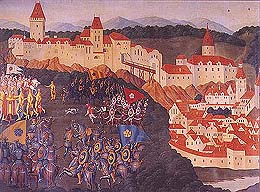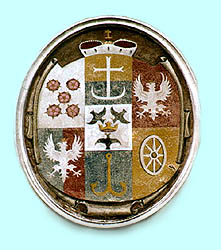Aristocratic Families in Český Krumlov
 Only four aristocratic
families entered eventful the historical development of Český
Krumlov as their residential domicile. The Bohemian-Krumlovian
castle was found by the Lords of
Krumlov who were the one from many branches of the Czech clan
the Vítkovcis.
Very soon a settlement around the castle began to form - the
foundation of the contemporaneous town. The Krumlovian branch of
the clan died out in 1302 and its property was passed to the
Rosenberg clan which was also one of the original branches of the
Vítkovci clan. Český Krumlov had been in possession of the Rosenbergs
for three centuries, so they went down in the history of the town
and the castle to a considerable extent.
Only four aristocratic
families entered eventful the historical development of Český
Krumlov as their residential domicile. The Bohemian-Krumlovian
castle was found by the Lords of
Krumlov who were the one from many branches of the Czech clan
the Vítkovcis.
Very soon a settlement around the castle began to form - the
foundation of the contemporaneous town. The Krumlovian branch of
the clan died out in 1302 and its property was passed to the
Rosenberg clan which was also one of the original branches of the
Vítkovci clan. Český Krumlov had been in possession of the Rosenbergs
for three centuries, so they went down in the history of the town
and the castle to a considerable extent.  Peter I von Rosenberg
influenced mainly the ecclesiastic life in the town in the first
half of 14th century because he helped to build a castle chapel
church of St. Jošt and a Minority monastery was found from his
bequest. Ulrich II von Rosenberg created a bastion of Roman
Catholic religion in the south of Bohemia from Český Krumlov in the
rough times during the Hussite wars. Český Krumlov reached its
biggest and unparalleled extent under the rule of Wilhelm von
Rosenberg as the town obtained its new - and present - quite lucid
Renaissance appearance. As Peter Wok von Rosenberg did not produce
an heir, he sold the Bohemian-Krumlovian dominion to the emperor
Rudolf II von Habsburg in 1601.
Peter I von Rosenberg
influenced mainly the ecclesiastic life in the town in the first
half of 14th century because he helped to build a castle chapel
church of St. Jošt and a Minority monastery was found from his
bequest. Ulrich II von Rosenberg created a bastion of Roman
Catholic religion in the south of Bohemia from Český Krumlov in the
rough times during the Hussite wars. Český Krumlov reached its
biggest and unparalleled extent under the rule of Wilhelm von
Rosenberg as the town obtained its new - and present - quite lucid
Renaissance appearance. As Peter Wok von Rosenberg did not produce
an heir, he sold the Bohemian-Krumlovian dominion to the emperor
Rudolf II von Habsburg in 1601.
With the approach of the new clan the Eggenbergs in 1622, Český Krumlov became the residential domicile of principality and Krumlovian duchy in 1628. During the rule of Johann Christian I von Eggenberg the town went through a new constructional and cultural boom as it witnessed a whole row of Baroque buildings in the town and even in the area of the chateau. The Eggenbergs were replaced the Schwarzenbergs in 1719 and residential Český Krumlov again became a significant cultural, political and social centre which went through a period of prosperity during the rule of Josef Adam zu Schwarzenberg. The agricultural and cultural boom of the town ceased in the second half of 19th century, a fact which ultimately had a positive influence on the preservation of the town's medieval appearance as industrial development did not erode the historical appearance of the centre. Český Krumlov was still under the administration of the Schwarzenberg clan until 1947.
(mj)


